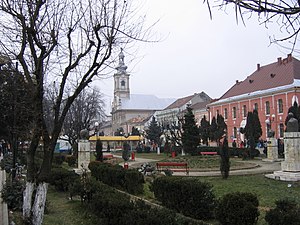Sighetu Marmației (Eng. Marmaroschsiget, Hungarian Máramarossziget) is a city in the district Maramureș in the northwest of Romania, right on the border with Ukraine. It has a beautiful old town with numerous historical buildings.
 | ||
| Sighetu Marmației Máramarossziget · Marmaroschsiget | ||
| Circle (județ) | Maramureș County | |
|---|---|---|
| Residents | 37.640 (2011) | |
| height | 274 m | |
| Tourist info web | http://www.primaria-sighet.ro/ | |
| no tourist info on Wikidata: | ||
| location | ||
| ||
background

The name Sighetu Marmației is a Romanization of the Hungarian name Máramarossziget, which means "island in Máramaros" (the former Hungarian county whose official seat the city was). Until 1964 the official name was just Sighet.
The first written mention of the city comes from the year 1326. Until the Treaty of Trianon in 1920 it belonged to the Kingdom of Hungary, since then to Romania. In the past the city was mainly inhabited by Hungarians. In the 1910 census, Hungarians (including Hungarian-speaking Jews) made up 82%, Romanians 9%, and Germans 6%. Jews made up the largest religious group with 37%, followed by Greek and Roman Catholics. Elie Wiesel, who later won the Nobel Peace Prize, was born in 1928 and is one of the city's most famous sons. In the 1950s and 60s, the communist secret police in Sighet ran a notorious prison for "class enemies". Today the ratio of the ethnic groups is almost reversed: Romanians make up the majority (82%), Hungarians are only a minority (13%), and there are also smaller minorities of Ukrainians and Roma. The largest religious group today are the Romanian Orthodox with 65%, followed by Catholics of the Roman and those of the Greek rite. There are almost no Jews left.
getting there
By plane
The nearest airports are those of Baia Mare (70 km / 1½ hours away by car) and Satu Mare (115 km / 2 hours), but only national connections, e.g. B. from Bucharest serve. The nearest major airport with international connections is 180 km (3 hours by car) away Cluj-Napoca
By train

Sighetu Marmației has a train station with direct connections from Cluj-Napoca above Vişeu de Jos and Salva. Although the train takes about 6 hours for the approx. 200 km from Cluj, the journey is particularly recommended in the Vișeu valley because of the scenic route. Connections can be found on the Romanian railway side mersultrenurilorcfr.ro.
Coming from the Ukrainian side, Sighetu Marmației can be reached via the train station in the neighboring town of Solotvyno. There is a daily night train from there Lviv above Uzhhorod.
By bus
Various bus companies offer numerous connections to and from Sighet. Goals include Baia Mare, Satu Mare, but also Oradea and more distant cities. A good starting point for research is the website autogari.ro.
In the street
The national road DN 18 from Baia Mare or Moisei and leads through Sighetu Marmației Vişeu de Suswhich forks here with the DN 19 from the direction of Satu Mare. From the Ukrainian neighboring town of Solotvyno it is possible to cross the border via a bridge over the Tisza.
By boat
mobility
Tourist Attractions
Churches, synagogues
- Biserica reformată, Mihaly Ioan de Apşa street 4. Reformed church, from the 14th century, in Gothic style, the oldest preserved building in the city.
- Biserica "Sf. Carol de Borromeo ”, Piața Libertății 17. Roman Catholic Church of St. Charles Borromeo, baroque, built 1730–1807.
- Biserica ucraineană "Înălțarea Sfintei Cruci", Str.Bogdan Vodă 5A. Ukrainian Orthodox Holy Cross Church, built 1791–1807.
- Sinagoga, Str.Bazarabia 10. Sephardic Synagogue, from 1900-04, the only surviving synagogue in the city.
- Jewish cemetery. With about 3000 graves.
reformed Church
Catholic Church of St. Charles Borromeo

Ukrainian Orthodox Church
synagogue
Buildings
- Fosta Prefectură, Mihaly Ioan de Apşa street 2. Former prefecture of Máramaros county, built in 1692, with restaurant "Curtea Veche".
- Hotel "Coroana" (formerly Hotel "Tisa"), Piața Libertății 8. 19th century, listed as a historic monument.
- Casa cu cariatide, 10 Bogdan Voda Street. House with the caryatids, built in 1890, today the “Luceafărul” bookshop.
- town hall, Str.Bogdan Vodă 14 Coposu Corneliu 2, 4. Former court, built 1893–1895.
- Palatul Cultural, Maniu Iuliu Street 31. Palace of Culture 1912–13 built in the style of a medieval castle.
Former prefecture, today restaurant "Curtea Veche"
House with the caryatids

town hall

Palace of Culture
Museums
- Muzeul Satului Maramureșean. Village museum of the Maramureș region (30 wooden houses from the 12th to 19th centuries and a wooden church from the 16th century that was moved here).
- Memorial and museum of the victims of communism in the former Sighet prison
- Museum of Jewish Culture. Elie Wiesel was born.
- Maramureș Ethnographic Museum
- Museum of Archeology, History and Natural History, in the former monastery from 1730.
- Cinema Mara, Piața Libertății 1. Old cinema with film museum, 19th century.
- House Ioan Mihaly de Apşas, Mihaly Ioan de Apşa street 17. Built in 1880, Mihaly de Apşa (1844-1914) was a Romanian historian, member of the Academia Română and author of a work on the history of the Maramureş region.
Elie Wiesel's birthplace
Cinema Mara
activities
shop
kitchen
nightlife
accommodation
Learn
Work
security
health
Practical advice
trips

- There are about 60 Wooden churches in the Maramureș, the eight most important of them are UNESCO World Heritage Sites. The closest to Sighetu Marmației is the one Church of the Introduction of the Blessed Virgin into the Temple in Bârsana (20 km southeast of Sighetu Marmației at the DJ 186 towards Săcel, just under half an hour by car)
- Happy cemetery(Cimitirul Vesel) in Săpânța: unusual cemetery, where all the tombs are colorfully decorated with naive paintings. 19 km west of Sighetu Marmației on DN 19 towards Satu Mare, a good 20 minutes by car.


.JPG/120px-Biserica_Reformata_-_(Sighetu_Marmatiei).JPG)




.JPG/99px-Casa_cu_cariatide_din_Sighet_(3).JPG)


.JPG/120px-Casa_Elie_Wiesel_din_Sighet_(5).JPG)
